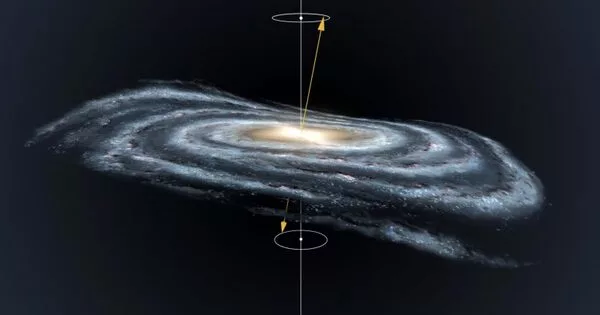Though scientists have long known from observational data that the Milky Way is warped and has flared edges like a skirt, no one has been able to explain why. Astronomers have now completed the first calculations that fully explain this phenomenon, with compelling evidence pointing to the Milky Way being engulfed in an off-kilter halo of dark matter.
The Milky Way galaxy is frequently portrayed as a flat, spinning disk of dust, gas, and stars. However, if you zoom out and take an edge-on photo, you’ll notice that it has a distinct warp, as if you tried to twist and bend a vinyl LP. Though scientists have long known from observational data that the Milky Way is warped and has flared edges like a skirt, no one has been able to explain why.
Harvard astronomers at the Center for Astrophysics | Harvard and Smithsonian (CfA) have now completed the first calculations that fully explain this phenomenon, with compelling evidence pointing to the Milky Way’s envelopment in an out-of-phase halo of dark matter. The research also adds to current theories about how the galaxy evolved and may shed light on some of the mysteries surrounding dark matter.
A tilted dark halo is actually fairly common in simulations, but no one had explored its effect on the Milky Way. It turns out that the tilt is an elegant way to explain both the magnitude and direction of our galaxy’s wobbly disk.
Jiwon Jesse Han
Jiwon Jesse Han, a Griffin Graduate School of Arts and Sciences student affiliated with the CfA, led the new calculations. The paper was published in Nature Astronomy and co-authored by Charlie Conroy and Lars Hernquist, both of whom are faculty members at the CfA and the Department of Astronomy.
Our galaxy is surrounded by a diffuse cloud known as the stellar halo, which extends much further into the universe. The Harvard team deduced in groundbreaking work published last year that the stellar halo is tilted and elliptical in shape, similar to a zeppelin or football.
Using that as a starting point, the team assumed the same shape for the dark matter halo, the larger entity that encompasses everything in and around the Milky Way. Dark matter accounts for 80% of the mass of the galaxy but is invisible because it does not interact with light, so the shape of the halo must be inferred. Using models to calculate the orbits of stars within a tilted, oblong dark matter halo, the team found a near-perfect match to existing observations of a warped, flared galaxy.

“A tilted dark halo is actually fairly common in simulations, but no one had explored its effect on the Milky Way,” Conroy said. “It turns out that the tilt is an elegant way to explain both the magnitude and direction of our galaxy’s wobbly disk.”
Scientists had long surmised that the Milky Way formed due to a galactic collision; the astronomers’ work further underscores that hypothesis.
“If the galaxy was just evolving on its own, it would have had this nice, spherical halo, this nice, flat disk,” Han said. “So the fact that the halo is tilted and has a football-like shape suggests that our galaxy experienced a merger event, where two galaxies collide.”
Their calculation of the probable shape of the dark matter halo may also provide clues to the properties and particle nature of dark matter itself, which are still mysteries in physics. “The fact that the galaxy is not spherical in our data implies that there is some limit to which dark matter can interact with itself,” he said.
Confidence in these findings could lead to better methods of studying the unobservable dark matter that makes up the majority of the universe. This includes new methods for detecting the kinematic signatures of dark sub-halos, which are tiny dark matter halos zipping around the galaxy.
















